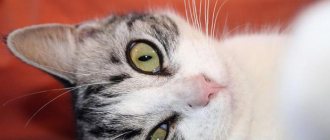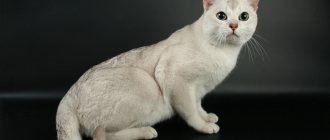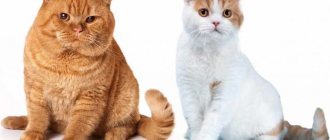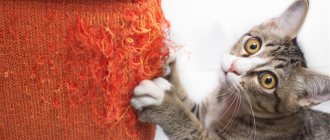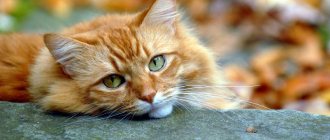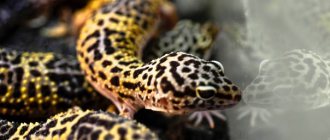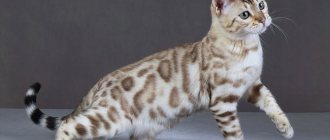Medical problems. (Maybe the cat is sick. Or maybe she’s sad?)
Do you love her as much as she does? What do you know about cats and their habits? A healthy cat quickly gets used to the place where it will live. She knows where the tray is. And with all her desire to mark the place where she lives, she will not do this either in the corridor, or in the rooms, or near her favorite chair, or in the kitchen. She respects her owners, understands and feels them. Having carefully eaten from her dishes, she will definitely go to the toilet on a tray that you have carefully cleaned. And he will sharpen his nails on a specially prepared piece of wood or a convenient scratching post. And, if the cat is sick or you are doing something wrong, from her point of view... Then you need to show more participation and attention to your little friend. Perhaps by observing her, you will understand the reason for the strange behavior. For example, check if your kitty is sick?
Factors influencing cat behavior
All cats behave differently. This is due to many factors:
- character and temperament, which largely depend on the breed. Thus, Siamese cats are jealous and capricious, but Maine Coons are kind, so they are best chosen by families with children. Outbred cats can have very different personalities, because it is not clear from which breeds they originated;
The behavior of a cat depends on the breed, for example, Maine Coons are generally friendly
- education. For a cat to grow up kind and affectionate, you need to talk to it, play with it, and take care of it. And on the contrary, for owners who devote little time to the animal, it can behave vindictively - shit in the slippers and on the bed, etc.;
- socialization. Sociopathic cats do not accept anyone at all (they do not allow themselves to be stroked, do not make contact, etc.), except perhaps the owner when he offers food. It is usually not easy with such animals, but at the same time they do not require much attention;
- trust in people. If you call a cat on the street, he may not come up because he is afraid of humans. This is usually how pets behave. And those who do not have a “roof over their ears” usually run up to be fed, but not all of them either. If a cat has been frequently abused, it may be afraid of everyone around it and not approach a person. Such stressed animals need rehabilitation - they need to be gradually accustomed to normal relationships with humans.
A cat living outside may be scared, which may cause her to not trust humans.
The cat is sick
Of course, the cat can get sick. And diseases in the cat tribe are often the same as in people. The cat has a cold and her ears hurt. She shakes her head and tries to get her paw into her ears. He even puts out his claws and scratches his skin a little. She may have diabetes, inflammation of the lungs and urinary tract, heart disease, or a tummy ache. You definitely need to show her to a veterinarian and treat her following his advice.
It is necessary to select food for your cat very carefully, since cats are, in fact, very picky animals. Read about cat feeding options here Cat Nutrition. But under no circumstances overfeed your cat. Obesity will not bring her health.
Just like people, when they are sick, a cat becomes moody when sick. Her character and habits change. And after recovery, these changes that upset you may remain. Only your tactful behavior can help return your cat to good old habits.
It was painful for her to go to the toilet and she stopped sitting on the tray, because now she associates the tray with illness. But when she was sick, she wanted to drink a lot. As a result, puddles left anywhere but in the tray increased in size. And your mood worsened. It seemed that by punishing the cat, you could force it to remain neat as before. But the cat, in response, began to be mischievous and even bite. Try moving the tray to a different place for a while and changing the filler so that her toilet reminds her of her illness as little as possible.
I'm a cat
Many owners of domestic cats consider their pets to be members of the family, see them as small children and communicate with them accordingly. However, we often forget that a cat is, first of all, an animal that has a behavior pattern that is radically different from a human one.
Thus, the faster the owner understands and accepts this fact, the faster their relationship will begin to be based on understanding and harmony. After all, the peculiarities of a cat’s behavior as a biological species directly affect its behavior and relationship to the world.
Agree, it would be strange to ask a fish not to swim in water and live on land, and a cat, once in your house, does not cease to be who it is, it is important not to forget about this.
Firstly, all representatives of the cat family are predatory animals, this fact is very strongly reflected in the daily behavior of the animal. Since the cat, being a predator, is at the top of the food chain, it is not a victim of persecution. Her world consists of possible victims and rivals who can cause various troubles. So sudden aggression towards a stranger can be explained by this fact.
Secondly, the predator clings to its territory and protects it in every possible way. Regular walks around the borders of their possessions serve as a preventive measure of protection against possible encroachments by rivals. This is why cats have a hard time with moving, changing their place of residence, and even rearranging furniture in the apartment, which changes the familiar landscape.
So a cat’s aggression towards a guest sitting on her sofa is a completely normal reaction. So, by scolding the animal for such behavior, the owner enters into a confrontation with it, and this only intensifies the conflict situation. Thus, it is necessary to show the animal that the guest is not an invader, but simply a passing visitor, in which case the aggression will most likely come to naught. After all, cats always react adequately to relatives who do not claim the territorial integrity of its possessions.
Thirdly, the cat is a solitary predator, relying only on itself. If you realize this fact and apply it to your pet’s behavior, it will immediately clarify many aspects that were previously incomprehensible and mysterious.
These wonderful animals always keep their ears to the ground and realize that in any situation they can rely solely on their own strength. This strong instinct manifests itself even after thousands of years of domesticated lifestyle.
It is interesting that in relation to humans, and especially to the owner, these animals are very loyal and allow him much more than their own relatives. Experts believe that the model of the relationship between furry pets and people is built on the basis of the “mother and child” line.
That is, the cat perceives the person as its own mother, and assigns itself the role of a kitten in need of care. Although some animals with a wayward character often try to change this line of behavior by taking on the role of the mother. In this case, the person is assigned the role of a kitten or cat of lower status.
Behavior correction (Teaching a cat not to be mischievous)
Consistently and persistently try to restore your good relationship. You are treating a cat. And she understands it. Even if the procedures are not always pleasant, the cat feels that you want the best for her. Her health is gradually improving and some physical educational aspects can be added.
For example, spray in those parts of the apartment where the cat went to the toilet, instead of a tray, with special deodorants, perfumes or citrus juice. Use strong scents, but don't overdo it. A cat has a delicate sense of smell and it must be protected and not create additional problems.
You can remind people of good manners by blowing thin streams of water from a spray bottle. A regular reminder like this will tell your cat that she is doing something wrong. You can’t jump on the table and push a lot of interesting things onto the floor, but they fall so wonderfully on the floor. You cannot sharpen your claws on the sofa and armchairs. The water will be a signal for the cat - you can’t do “this”. And, at the same time, it will seem to come not from the owner. Therefore, there is nothing to be angry with him for.
Psychology of cats and features of its behavior
A cat needs freedom and independence.
And so that living together is not overshadowed by hassle and scandals, the owner needs to find a common language with his pet. It is necessary to achieve mutual understanding between the cat and the person. Only education and patience can a human attitude towards a cat be based, and this cannot be achieved without knowledge of their system of signs, which manifest themselves through their behavior and are a kind of cat language. And they know quite a few techniques that allow them to demonstrate their desires and feelings - this is their voice, peculiar cat gestures and facial expressions.
Gestures, facial expressions and posture
The cat in its arsenal, as already mentioned, has enough opportunities to express its intentions and insistence. This includes body plasticity, demeanor, various poses, and a voice with a wide range of sound shades. The owner needs to master certain skills that allow him to determine the main signals given by the cat in order to understand what state it is in. These signals are primarily: posture, position of the tail, ears and, of course, the voice.
If a cat is scared, then, as if wanting to become invisible, it presses tightly to the ground, its ears lie close to its head and lean back, the cat is ready to run away at any moment. Well, when it’s very scary, her fur stands on end and her pupils dilate.
If the danger that has arisen does not pass, then the cat begins to get very nervous and begins to take active action. She proceeds to intimidate her enemy, performing actions such as hissing, waving her paws, spitting, and at the same time being ready to chirp at any moment. But the cat does all these actions exclusively for defensive purposes.
The most important indicator of a cat's very strong arousal—whether fearful, extremely confused, or threatened—is the hump.
This pose with an arched back, raised fur, tense legs, tightly pressed ears, and a cat hissing tells us that she is ready for defense and possible escape.
If the situation is not in its favor, the cat begins to back away. At the same time, the front paws move a little faster than the hind paws, which leads it to turn around, and it becomes sideways towards its danger. Well, then depending on the circumstances. In the case when the cat believes that there are no obstacles to escape, it runs away as best it can. If this is not possible, then swings of the front paws, lunges, sharp throws and growls are used, thereby trying to discourage the enemy, and having confused him with these actions, try to escape again. Very rarely, only in case of extreme fright, a cat can lose its head and attack.
Cat instincts
This is the point on which it is necessary to dwell in more detail. After all, it is animal instincts that for the most part determine the line of cat behavior. And this cannot be completely corrected. It is possible to only slightly correct some behavioral aspects, and this is not always the case.
First of all, you should remember that cats, although small, are still predators. Instinctively defending their own territory, they can be quite aggressive. And if in the wild their legal territory is quite extensive, then at home they have to be content with a “personal” chair.
Which, by the way, is always trying to be sat on by one of the strangers who has come to visit the owner.
Another instinct that will never be eradicated is the hunting instinct. Small predators living in the confined space of an apartment have neither natural enemies nor the opportunity to hunt. Therefore, cats instinctively divide everything around them into prey and enemies.
Potential prey can include all moving objects, and enemies can include all frightening objects (such as a vacuum cleaner, washing machine and other household appliances).
But, despite their unquenchable instincts, cats have a special relationship with humans. And they allow him much more than they would allow any other animal. There is an opinion that cats and humans develop a “mother-child” behavior model, in which cats choose the role of a kitten.
And a person is allowed to take care of himself. But it also happens the other way around: an animal tends to take on the role of a dominant creature and try to subjugate a person, or they see him as a natural enemy. Rarely, of course, but such a behavioral model does occur.
Mainly if the cat is taken into the home at a fairly adult age, and has a fairly independent and willful character.
Characters of cats of different breeds
The characters of cats of different breeds can be divided into 3 groups:
- sociable and sociable;
- calm and balanced;
- powerful and proud.
It is very difficult to answer the question of which cat’s character is better; it all depends on what is closer to you. Each group has its own characteristics that must be taken into account when choosing a kitten. By the way, precisely in order to know what to expect from a cat in terms of character and behavior, it is better to give preference to purebred animals. Each breed is characterized by certain well-established specific behavioral characteristics. The likelihood that a cat's behavior will correspond to expectations will be higher in pets with a pedigree.
Sociable and sociable
Cats whose characteristic feature is excessive sociability simply adore their owners! Kotofey can spend hours with his family, keep an eye on everyone and keep up the conversation with a cheerful meow - a real “life of the party.” When there is someone at home, the cat does not leave a single step from him, rubs against his legs, lies in his arms, and jumps on his shoulder. In some ways, cats of this type can even be called annoying; some consider them clingy. But here it is important that such cats are taken into the home specifically for communication, since these animals vitally need the presence of a person nearby. They have difficulty experiencing loneliness, so they are not suitable for extremely busy people who return home only to sleep. In addition, sociable cats cannot tolerate rough treatment; they only understand the language of affection.
The other side of the coin is the jealousy of cats. They become so attached to their owner that they do not want to share him with anyone - neither with other pets nor with family members.
The group of “social and sociable” cats includes the Siamese cat, German Rex, Canadian Sphynx, Oriental and Bengal cats.
Siamese cat
German Rex
Canadian Sphynx
Oriental cat
Bengal cat
Calm and balanced
The calmness and balance of these cats are the result of a very stable nervous system. Animals that belong to this subgroup by nature never show aggression. Calm cats are perfect for families with small children. Affectionate and flexible, they will never be too intrusive. Such cats do not pester people on their own, but they will gladly allow themselves to be picked up, stroked or scratched behind the ears.
However, even with such balanced cats, caution must be exercised. If you hurt them, even by accident, the result may be a sudden change in behavior - the cat will struggle, try to run away, and may inadvertently scratch or bite. To paraphrase the English poet John Dryden, let's say: “Fear the wrath of the patient cat.”
In this group, the following breeds have the most flexible character: Siberian cat, Russian Blue, American Curl, Norwegian Forest, Burmilla and Burmese cat.
Siberian cat
Russian blue cat
American Curl
Norwegian Forest Cat
Burmilla
Burmese cat
Powerful and proud
Most often, pride, independence and authority are characteristic of breeds that were developed on the basis of wild cats through direct selection. Accordingly, they retained natural habits from their wild ancestors, not least of which are the desire to dominate and self-sufficiency.
Coexisting side by side with such a cat, even for many years, one cannot say that it becomes completely domestic. Such cats do not tend to form strong attachments to humans. They would be offended by the definition of “our smaller brothers” - these are full-fledged and full-fledged members of the family, whose opinions will have to be taken into account. Cats will be docile and affectionate, but only until the moment when they themselves want to exchange mercy for anger. It is better not to have pets from this group for families with children, because it is difficult to predict the behavior of such a cat. It may simply be dangerous for a child to be near her.
On the other hand, a strong and independent cat is an excellent partner for busy people. She feels great alone and minds her own business. For the same reason, such a cat should be the only pet in the house - it has difficulty getting along with other animals.
The most popular representatives of this group are Maine Coon, British and Persian cats, Kuril and Japanese bobtails.
British Shorthair
Persian cat
Kurilian Bobtail
Japanese Bobtail
Maine Coon
